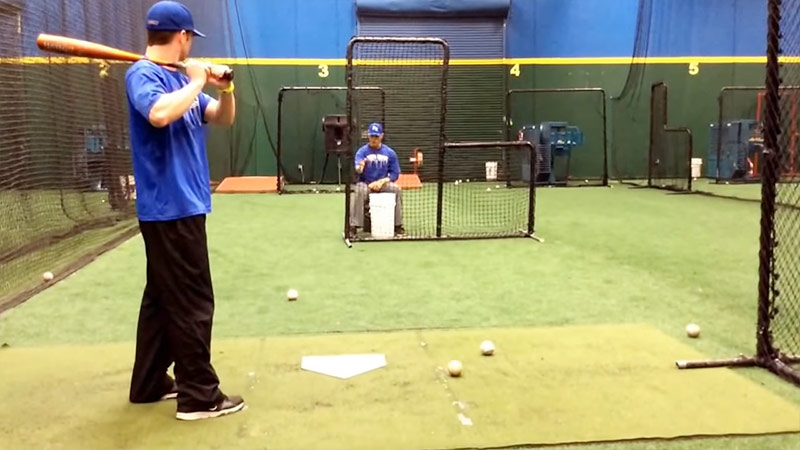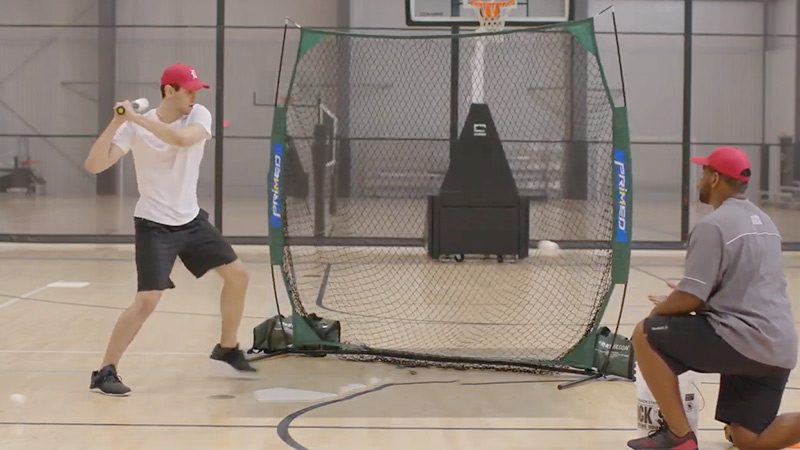Soft toss is a popular training technique used in baseball to improve a player’s hitting skills and hand-eye coordination.
It involves a coach or a teammate tossing softballs or baseballs from a short distance to the batter, allowing them to practice their swing mechanics and develop their timing and contact skills.
Soft toss is widely employed at all levels of baseball, from youth leagues to the professional ranks, and serves as an effective drill for hitters to refine their technique and build muscle memory.
In this article, we will explore the concept of soft toss in baseball, its benefits, and how it can contribute to a player’s overall development. So, let’s get into a deep discussion now.
What is Soft Toss in Baseball?
Soft toss is a widely used training technique in baseball that involves a coach or a teammate tossing softballs or baseballs from a short distance to a batter.
The purpose of the soft toss is to help players improve their hitting skills, develop hand-eye coordination, and refine their swing mechanics.
Soft toss drills are typically conducted in a controlled environment, allowing hitters to focus on their technique and build muscle memory.
Soft toss allows players to work on various aspects of their hitting technique, such as timing, bat speed, and contact point. By repetitively practicing swings against soft toss, batters can refine their mechanics and develop consistency in their swing.
What is No Soft Toss?

“No soft toss” refers to a training approach where hitters do not engage in soft toss drills. This may be a deliberate choice by coaches or players based on their training philosophy, available resources, or specific needs.
While soft toss is a popular method for developing hitting skills, some teams or individuals may choose to focus on other training techniques or prioritize different aspects of the game.
Reasons why Soft toss isn’t used so frequently:
Limited Resources
Some teams or players may not have access to the necessary equipment or facilities required for soft toss drills. Factors such as space constraints, lack of equipment, or logistical issues can make it challenging to incorporate soft toss into their training regimen.
Emphasis on Other Techniques
Coaches or players may prioritize different training techniques that they believe are more effective for their specific goals.
This could include live batting practice, tee work, or machine pitching, which may be preferred over soft toss based on their training philosophy or desired outcomes.
Game Simulation
For certain players, replicating game situations accurately may be a higher priority than soft toss drills. They may prefer to face live pitching or engage in simulated game scenarios to better simulate the challenges they will encounter during actual games.
Specific Needs
Depending on the individual player’s weaknesses or areas for improvement, the coaching staff may determine that other training methods are better suited to address those specific needs.
For example, if a player struggles with timing, they may focus more on drills that emphasize pitch recognition and adjusting to different speeds.
Rules of Soft Tosses
Soft toss drills follow certain rules and guidelines to ensure effectiveness and safety. These rules include:
Safety Precautions
Safety should always be a priority during soft toss drills. Coaches or teammates tossing the balls should stand at a safe distance and avoid putting themselves in the line of the batter’s swing.
Proper Pitching Technique
The coach or teammate conducting the soft toss should use a proper pitching technique to replicate game-like conditions. This includes maintaining consistency in the pitch location, speed, and trajectory.
Adjustments for Different Skill Levels
Soft toss drills can be modified to suit players of different skill levels. Beginners may start with slower pitches and gradually progress to faster speeds, while more advanced players can handle a wider range of pitch variations.
Feedback and Correction
Soft toss drills provide an opportunity for coaches to observe and provide feedback to hitters. They can offer guidance on proper swing mechanics, timing, and adjustments needed to improve performance.
Role of Soft Toss for Specific Skills Development
Soft toss drills serve as an effective tool for developing specific skills in baseball. Some key areas where soft toss can contribute to a player’s development include:
Hand-Eye Coordination
Soft toss drills require hitters to track the trajectory of the ball and make precise contact. Regular practice can enhance hand-eye coordination, allowing players to make better contact with pitches during games.
Swing Mechanics
Soft toss provides an opportunity for players to focus on their swing mechanics without the pressure of a live pitch. It allows hitters to refine their technique, work on proper weight transfer, and develop a consistent swing path.
Timing and Rhythm
Soft toss drills help players develop their timing and rhythm by providing a controlled environment where they can adjust their swing to match the pace of the toss. This can translate to improved timing when facing live pitching.
Contact Skills
Soft toss allows players to work on their ability to make solid contact with the ball. By repeatedly practicing hitting the ball thrown from a short distance, hitters can develop their ability to square up the ball and make consistent contact.
Advantages of Soft Toss in Baseball

Soft toss drills offer several advantages for baseball players at all levels. Some of the key advantages include:
Repetition and Muscle Memory
Soft toss drills provide hitters with the opportunity to repeat their swing mechanics and build muscle memory. By consistently practicing proper technique, players can develop more efficient and effective swings.
Controlled Environment
Soft toss allows hitters to focus on their technique in a controlled environment. With the coach or teammate tossing the ball from a short distance, hitters can concentrate on specific aspects of their swing without the variables and pressures present in live game situations.
Customization
Soft toss drills can be customized to address specific areas of improvement for individual players. Coaches can tailor the drills to focus on particular swing mechanics, pitch locations, or other skill development needs.
Confidence Building
Soft toss drills can help build confidence in hitters. By repeatedly making solid contact and seeing positive results in a controlled setting, players can gain confidence in their abilities, which can translate to improved performance in game situations.
Time Efficiency
Soft toss drills can be conducted efficiently and require minimal space and equipment. They can be incorporated into individual or team practice sessions as warm-up exercises or focused skill development activities.
Significance of Soft Toss in Baseball

Soft toss is a fundamental drill in baseball that holds great significance in the development of a player’s hitting skills.
It involves a coach or teammate gently tossing the ball underhand to the batter, allowing them to practice their swing mechanics, timing, and hand-eye coordination.
Soft toss may seem simple, but it plays a crucial role in a hitter’s overall performance and has several key benefits.
Let’s explore the significance of soft toss in baseball by examining its impact on technique, timing, pitch recognition, and hand-eye coordination.
Refining Technique: Breaking Down the Swing
Soft toss provides an opportunity for hitters to focus on their technique and make necessary adjustments. By eliminating the challenges of facing live pitching or faster throws, hitters can concentrate on refining their swing mechanics.
Soft toss allows them to break down their swing into smaller components and make corrections to enhance their overall form and efficiency.
Hitters can work on aspects such as hand placement, weight transfer, and bat path. The controlled environment of soft toss enables players to concentrate on specific areas of improvement, leading to better overall technique and consistency.
Developing Timing and Pitch Recognition
Timing is a critical aspect of hitting in baseball. Soft toss drills help hitters improve their timing and pitch recognition skills. Since the tosses are consistent and predictable, hitters can work on tracking the ball and developing their ability to time their swing accurately.
This is crucial in translating their skills to live game situations, where pitch speed and movement add complexity. The repetitive nature of soft toss allows hitters to gain confidence and develop a better sense of timing, ultimately leading to improved plate discipline and the ability to make solid contact with different pitches.
Enhancing Hand-Eye Coordination
A soft toss is an effective tool for building hand-eye coordination, a vital skill for success at the plate. Hitters must track the trajectory of the ball and precisely connect their bat with the incoming toss.
This drill trains their eyes to focus on the ball and make split-second judgments, honing their ability to recognize pitch location and adjust their swing accordingly.
By regularly practicing soft toss, hitters can develop sharper hand-eye coordination, which translates to improved performance at the plate. The ability to track the ball effectively and make solid contact is crucial for hitting success in baseball.
FAQs
What equipment is needed for soft toss drills?
For soft toss drills, you will need softballs or baseballs, a batting tee or a net to catch the balls and a bat.
How does soft toss help improve a player’s hitting skills?
Soft toss allows players to focus on their swing mechanics and develop their hand-eye coordination. It helps them practice their timing, contact, and overall swing technique in a controlled environment.
Can soft toss be used for both individual and team practice?
Yes, soft toss can be used for both individual and team practice. Individual players can incorporate soft toss into their training routine, and coaches can use soft toss drills during team practices to help hitters refine their skills.
Are there any specific techniques or strategies for effective soft toss drills?
To make soft toss drills more effective, coaches or teammates should aim to replicate game-like conditions by varying the pitch locations, speeds, and types of pitches thrown.
They should also provide feedback and guidance to the hitters to help them improve their swing mechanics.
Can soft toss be used as a warm-up exercise before games?
Yes, soft toss can be used as a warm-up exercise to help hitters get their timing and swing mechanics in tune before games.
It allows them to focus on their technique and build confidence before stepping into the batter’s box.
Conclusion
In conclusion, soft toss is a valuable training technique in baseball that allows players to improve their hitting skills and hand-eye coordination.
It provides an opportunity for hitters to refine their swing mechanics, practice their timing and contact, and develop muscle memory.
Soft toss drills can be conducted individually or as part of team practices, and coaches can customize the drills to replicate game-like conditions.
Whether used as a regular training exercise or as a warm-up routine before games, soft toss is an effective tool for hitters to enhance their performance and contribute to their overall development as baseball players. Best wishes.







